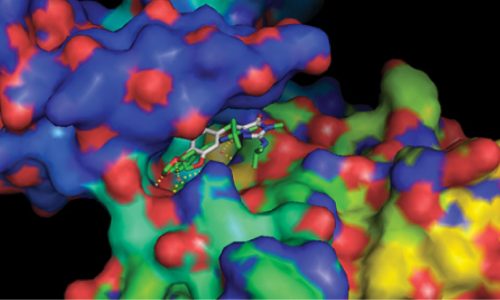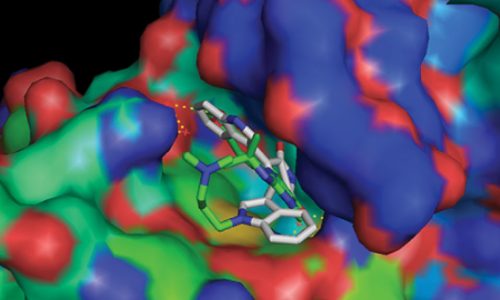The offer is valid only for USA territories and excludes territories outside the USA
The offer is valid only for USA territories and excludes territories outside the USA
The offer is valid only for USA territories and excludes territories outside the USA


A field of interest is to create and evaluate targeted molecular imaging agents (TMIAs) that detect cancers by using confocal fluorescent microscopy (CFM). Cancer is one of the main causes of death worldwide, accounting for 8.2 million deaths in 2012 (World Health Organization 2015). Tissues and organs are three-dimensional so 3D cellular models provide a stronger understanding of how the tumor grows than 2D culture.


Cancer cells growing in a 2D culture dish stained with Nuc Blue and MitoTracker. Note the flattened morphology. Nuc Blue stains the nuclei in the cells and MitoTracker Red stains the mitochondria.


Graphical view of the interaction between the protein ( blue, green, red surface) and the ligand (green, blue and grey sticks). Yellow dashes display polar contacts between the protein and ligand.
Another area of interest is drug design using molecular docking programs to study proteins involved in cancer for the purpose of finding better inhibitors. The PI3K/ AKT/mTOR pathway is one of the most important pathways related to different cancers. Faulty signaling in the PI3K/AKT pathway can lead to resistance to cancer therapies. This pathway is controlled by tyrosine kinases and regulates cell growth, proliferation and survival. AKT is a protein kinase b and its over phosphorylation can lead to uncontrolled cell growth. Phosphorylation is the most common biochemical modification that may alter the activity of a protein or regulate an enzyme by turning it on or off. AKT is activated when both serine and threonine residues are phosphorylated. Then active AKT phosphorylates many nuclear and cytosolic proteins like GSK3 beta that have crucial roles in cell survival and metabolism. Glycogen synthase kinase 3, beta plays an important role in the regulation of many cellular functions including growth, cell cycle progression, embryonic development and apoptosis. Therefore, inhibition of over phosphorylation is essential in cancer therapies. Molecular docking programs are used to predict the position of ligands within the binding pocket of the protein before testing for potential drugs in vitro.
Osaki M., Oshimura M., Ito H. PI3K-Akt pathway: its functions and alterations in human cancer.
Apoptosis. 2004;9(6):667–676. doi: 10.1023/b:appt.0000045801.15585.dd.
Bardhi K, Bardhi K, Craig P, Bernstein H. Targeting AKT pathway in glioma by using bioinformatics tools. Rochester Institute of Technology.2015.
Yamada, K. M. & Cukierman, E. Modeling tissue morphogenesis and cancer in 3D.
Cell 130, 601–10 (2007).
Bardhi K, Evans I.Utilizing 2-D, 3-D Collagen Cultures to Represent In Vivo Cancerous Tumors and to Test Targeted Molecular Imaging Agents. Rochester Institute of Technology.2015.
| Cookie | Duration | Description |
|---|---|---|
| cookielawinfo-checkbox-analytics | 11 months | This cookie is set by GDPR Cookie Consent plugin. The cookie is used to store the user consent for the cookies in the category "Analytics". |
| cookielawinfo-checkbox-functional | 11 months | The cookie is set by GDPR cookie consent to record the user consent for the cookies in the category "Functional". |
| cookielawinfo-checkbox-necessary | 11 months | This cookie is set by GDPR Cookie Consent plugin. The cookies is used to store the user consent for the cookies in the category "Necessary". |
| cookielawinfo-checkbox-others | 11 months | This cookie is set by GDPR Cookie Consent plugin. The cookie is used to store the user consent for the cookies in the category "Other. |
| cookielawinfo-checkbox-performance | 11 months | This cookie is set by GDPR Cookie Consent plugin. The cookie is used to store the user consent for the cookies in the category "Performance". |
| viewed_cookie_policy | 11 months | The cookie is set by the GDPR Cookie Consent plugin and is used to store whether or not user has consented to the use of cookies. It does not store any personal data. |
Text after title text example